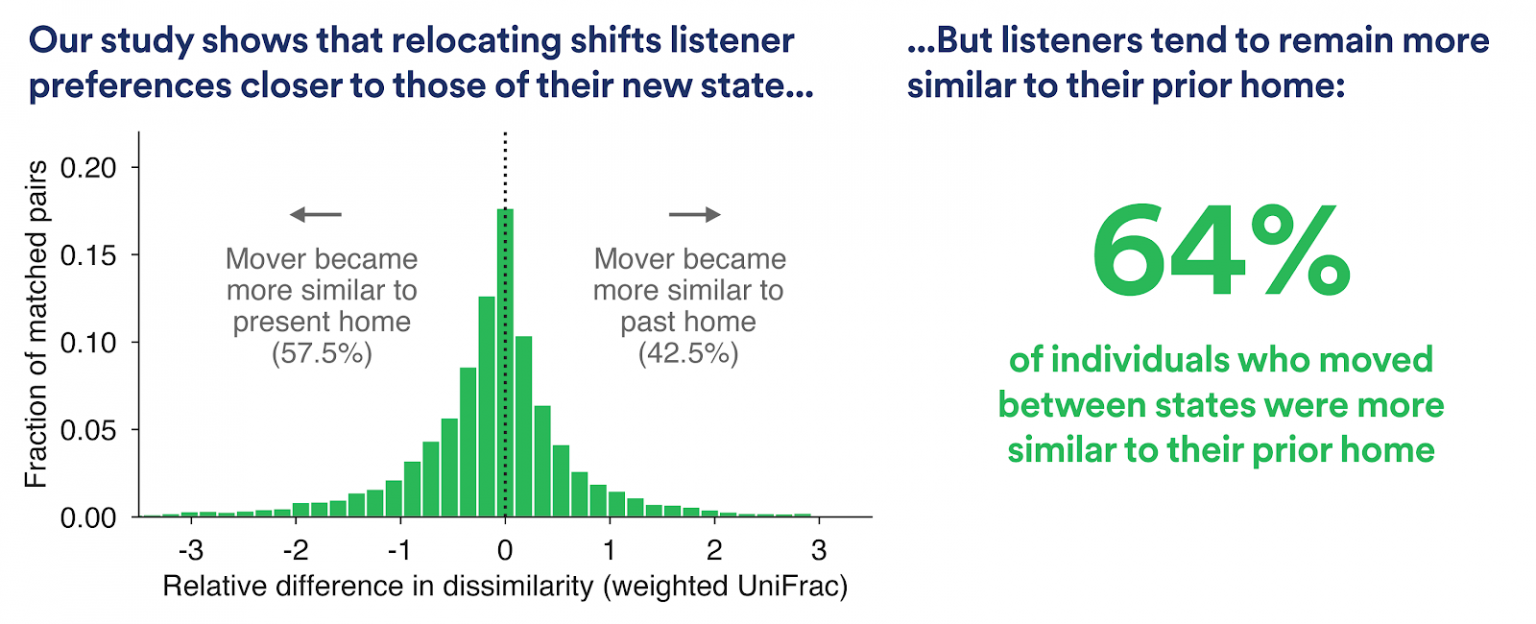Environmental Changes and the Dynamics of Musical Identity

“What kind of music do you like?” When getting to know someone, music is often one of the very first topics we explore together. And for good reason: our musical tastes say a lot about us. They reflect the important people, places, and times in our lives. But as these things potentially change, what happens to our musical tastes? Do they shift to reflect our recent friends and environments? Or do they remain fixed, reflecting our past?
In a study presented at the 2019 International Conference for Web and Social Media (ICWSM), we investigated these very questions, focusing on the role that environment plays in shaping our musical tastes. Specifically, we wanted to know if moving from place to place tends to make our tastes more diverse, and whether our tastes shift to look more like our new homes, perhaps less like our old ones. Our study considered all listeners in the US and defined “place” by the states in which listeners reside.
Past research has shown that when people describe their musical tastes to others (e.g., when answering the lead-in question above), they tend to do so by referencing genres. For this reason, we characterized listeners according to the distribution of genres that they stream on Spotify and measured whether that distribution changes when someone relocates.

Many genres are popular in different parts of the country. But does moving from one part to another change listeners' musical tastes?
Measuring how musical tastes change as a result of relocation poses significant technical challenges. First, for a variety of reasons, running a proper experiment here is infeasible. But, millions of Americans move every year, many of them across state lines and most, we assume, for reasons besides shaping their musical preferences. These moves — which our research identified via changes to listeners’ primary streaming locations — afford opportunities to derive natural experiments in which we match up and compare listeners who moved to similar listeners who didn’t. These “musical twins” form the basis for much of the analysis in our paper.

Over long periods, relocation shifts listener preferences to be more like the person’s new state, but those individuals tend to remain more similar to their prior state (i.e., disregarding the matching setup).
Comparing these pairs of listeners, we found that moving has little impact on diversifying a listener’s tastes. And, while our tastes do shift slightly to reflect our new homes, listeners remain more similar overall to their past homes. Together, these results suggest that musical tastes are largely robust to changes in listeners’ environments and tend to instead reflect the places that we’ve lived in the past.
To get a better sense of when and therefore which environments from the past might influence our musical tastes, we investigated the relationships between the ages of listeners and the music they consume. We found that listeners disproportionately listen to music released when they were 12-22 years of age. This suggests that musical tastes take shape during adolescence (alongside other forms of individual identity) and reflect our environments in this period.

The distribution of song vs. listener age highlights the importance of adolescence in musical identity formation. The green vertical band indicates that listeners disproportionately stream music that was released when they were 12-22 years of age.
Our study answers questions about how and when a listeners' environment shapes their tastes in music, but it also motivates other questions for future research. Naturally, defining “place” at the level of states has its limitations. Expanding to the country level, for example, would inform questions about the transmissibility and robustness of cultures around the world, where zooming in to smaller scales could inform the effects of urban/rural environments and people’s fondness for local content.
Exploring each of these ideas would teach us a lot about how to interpret our answers to “what kind of music do you like?”



